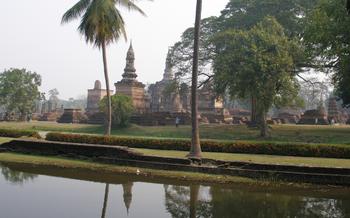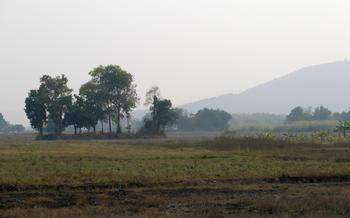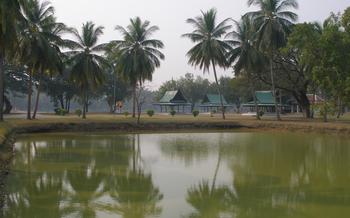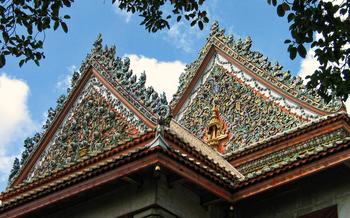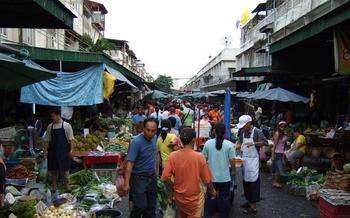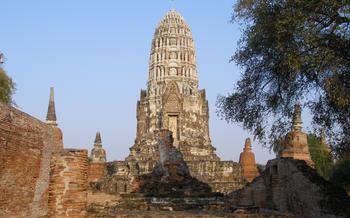
Phra Si Rattana Mahathat Temple Museum
- Atop the Hill: A Historical Overview
- Architectural Splendors: Unveiling the Temple's Design
- The Buddha's Abode: Exploring the Temple's Shrines
- Whispers of the Past: Delving into the Temple's Museum
- Pilgrimage and Festivals: A Time for Devotion
- A Walk Through Time: Exploring the Temple Grounds
- Spiritual Retreat: Finding Inner Peace
- The Local Connection: Interacting with the Community
- Photography Haven: Capturing the Temple's Essence
- Getting There: A Journey to the Temple
- Hours of Operation and Admission Fees
- Respectful Etiquette: Temple Dos and Don'ts
- Local Cuisine: Tantalizing Flavors Near the Temple
- Must-Try Dishes and Culinary Specialties
- Vegetarian and Vegan Options
- Tips for Finding Authentic and Affordable Local Cuisine
- Souvenirs and Mementos: A Piece of Phitsanulok
- Insider Tip: Hidden Gems and Local Secrets
Atop the Hill: A Historical Overview
Perched atop a hill overlooking the picturesque city of Phitsanulok, the Phra Si Rattana Mahathat Temple proudly stands as a testament to Thailand's rich cultural heritage and religious devotion. Its history is deeply intertwined with the rise and fall of the ancient Sukhothai Kingdom, which once ruled over this region. Constructed in the 14th century, the temple served as a royal monastery and was revered as a sacred site for the Sukhothai kings. Its architectural grandeur and religious significance have made it a revered destination for pilgrims and travelers alike, seeking spiritual enlightenment and historical exploration.
The temple's architectural design embodies the essence of Sukhothai art and architecture, characterized by its graceful curves, intricate carvings, and towering stupas. Its religious importance stems from its enshrinement of the Phra Buddha Chinnarat, one of Thailand's most revered Buddha images, believed to possess miraculous powers and attract devotees from far and wide.
Over the centuries, the temple has undergone several renovations and expansions, reflecting the changing political and religious landscape of Thailand. It has survived wars, natural disasters, and the passage of time, emerging as a symbol of resilience and continuity. Today, the Phra Si Rattana Mahathat Temple stands as a living testament to the enduring spirit of the Thai people and their unwavering faith in Buddhism.
Architectural Splendors: Unveiling the Temple's Design
The Phra Si Rattana Mahathat Temple boasts a unique architectural style that blends traditional Thai elements with influences from Sri Lankan and Khmer cultures. The temple's most striking feature is its distinctive prang, or spire, which rises majestically above the surrounding landscape. The prang is adorned with intricate carvings and sculptures, each representing a different aspect of Buddhist mythology.
The temple's main sanctuary, known as the ubosot, is another architectural marvel. It features a beautifully carved wooden gable and a series of murals depicting scenes from the Buddha's life. The ubosot is also home to the temple's main Buddha image, which is revered by devotees from all over the country.
The temple's grounds are dotted with a variety of other structures, including stupas, chedis, and salas. Each of these structures has its own unique significance and contributes to the temple's overall architectural harmony.
The Phra Si Rattana Mahathat Temple is a testament to the skill and artistry of the ancient Thai people. Its unique blend of architectural styles and intricate details make it one of the most beautiful and significant temples in Thailand.
The Buddha's Abode: Exploring the Temple's Shrines
At the heart of the Phra Si Rattana Mahathat Temple Museum lies a serene sanctuary where devotees and visitors alike seek spiritual solace and pay homage to the sacred Buddha images. The main Buddha image, known as Phra Buddha Chinnarat, is a masterpiece of Buddhist art, revered for its exquisite craftsmanship and believed to possess miraculous powers. This awe-inspiring statue, cast in bronze and adorned with gold leaf, exudes an aura of tranquility and invites contemplation.
Smaller Buddha images, each with their own unique story and significance, are enshrined within the temple's many shrines. These sacred figures represent different aspects of the Buddha's life and teachings, providing devotees with opportunities to connect with the divine in various ways. Altars and offerings, adorned with flowers, candles, and incense, further enhance the spiritual atmosphere of the temple, as devotees express their gratitude and devotion.
Rituals and ceremonies, performed by monks and lay practitioners, add to the vibrancy of the temple's spiritual life. These sacred rites, accompanied by chanting and the rhythmic sound of gongs, create a sense of connection between the earthly and the divine, allowing participants to deepen their spiritual journey.
Whispers of the Past: Delving into the Temple's Museum
Enrich your understanding of Phra Si Rattana Mahathat Temple's profound history and religious significance by exploring its captivating museum. Within its walls, a treasure trove of artifacts and relics awaits, whispering tales of the temple's glorious past and the deep devotion that has permeated its halls for centuries.
The museum's collection meticulously preserves ancient Buddha images, intricately carved sculptures, and remnants of past architectural marvels. Each artifact holds a story, narrating the evolution of the temple's design, the influences that shaped its architecture, and the unwavering faith of its devotees.
Interactive exhibits and educational programs bring the temple's history to life, providing insights into the rituals, ceremonies, and spiritual practices that have taken place within its sacred walls. Through these immersive experiences, you'll gain a deeper appreciation for the profound impact the temple has had on the lives of countless believers.
As you wander through the museum's galleries, let the whispers of the past guide you on a journey of discovery. Unravel the secrets of this sacred site, and immerse yourself in the rich tapestry of its history, culture, and religious traditions.
Pilgrimage and Festivals: A Time for Devotion
The Phra Si Rattana Mahathat Temple holds a significant position as a pilgrimage site for Buddhists from across Thailand and beyond. Devotees embark on spiritual journeys to pay homage to the sacred Buddha images enshrined within the temple. The temple's reputation for spiritual significance attracts pilgrims seeking blessings, guidance, and inner peace.
Throughout the year, the temple hosts a variety of festivals and celebrations that draw large crowds of local residents and visitors. These festivals showcase the rich cultural heritage of Phitsanulok and provide an opportunity for devotees to come together and celebrate their shared faith. The most prominent festival is the annual temple fair, which takes place over several days and features colorful processions, traditional performances, and lively market stalls.
During these festivals, the temple transforms into a vibrant hub of activity. The air fills with the sounds of chanting, music, and laughter as devotees participate in rituals, make offerings to the Buddha images, and receive blessings from the monks. The temple's courtyards and shrines are adorned with elaborate decorations, creating a mesmerizing visual spectacle.
Participating in the temple's festivals is an enriching experience that offers a glimpse into the vibrant religious traditions of Thailand. Visitors can immerse themselves in the festivities, interact with the local community, and gain a deeper understanding of the role of Buddhism in Thai culture.
A Walk Through Time: Exploring the Temple Grounds
As you wander through the temple grounds, you'll be captivated by the intricate layout and design of the complex. The main temple structure stands tall and commanding, surrounded by a myriad of smaller buildings, stupas, and decorative elements. Each structure holds its own significance, contributing to the temple's rich history and spiritual essence.
Admire the magnificent stupas, adorned with intricate carvings and shimmering spires that reach towards the sky. These monuments represent the Buddha's relics and symbolize the path to enlightenment. Explore the serene courtyards, where lush gardens and tranquil ponds create an atmosphere of peace and harmony.
Don't miss the opportunity to marvel at the exquisite sculptures that grace the temple grounds. These intricate artworks depict various deities, mythical creatures, and scenes from Buddhist mythology. Each sculpture tells a story, offering a glimpse into the temple's deep-rooted beliefs and traditions.
As you stroll through the grounds, let the serene ambiance wash over you. The gentle sound of chanting monks, the fragrance of incense, and the peaceful surroundings combine to create a truly spiritual experience. Immerse yourself in the temple's tranquility and allow your mind to find solace and inner peace.
Spiritual Retreat: Finding Inner Peace
Beyond its architectural and historical significance, the Phra Si Rattana Mahathat Temple serves as a sanctuary for spiritual exploration and inner peace. Its serene atmosphere, coupled with the rich Buddhist traditions, provides an ideal setting for meditation and self-discovery. Visitors seeking tranquility can find solace within the temple's tranquil courtyards, surrounded by the soothing sounds of chanting monks and the gentle tinkling of wind chimes. Guided meditation sessions and teachings are often offered, allowing travelers to deepen their understanding of Buddhist practices and cultivate mindfulness. Whether you're a seasoned meditator or simply seeking a moment of respite, the Phra Si Rattana Mahathat Temple offers a transformative experience that nourishes the soul and promotes inner peace.
The Local Connection: Interacting with the Community
When visiting Phra Si Rattana Mahathat Temple Museum, take the opportunity to interact with the friendly locals who reside in the surrounding community. These warm and welcoming people are eager to share their beliefs, customs, and way of life with visitors. Engage in conversations with them to learn about their unique perspectives and gain a deeper understanding of Thai culture. Ask questions, listen attentively, and show genuine interest in their stories.
Support local businesses by patronizing the shops, restaurants, and stalls that line the streets near the temple. Sample the delicious local cuisine, purchase handmade souvenirs, and contribute to the economic well-being of the community. Many of these businesses are family-run, and your support helps preserve traditional livelihoods and cultural heritage.
By interacting with the locals, you'll create meaningful connections and foster cultural exchange. This interaction adds a personal touch to your visit and provides a glimpse into the lives of the people who call this sacred place home.
Photography Haven: Capturing the Temple's Essence
The Phra Si Rattana Mahathat Temple Museum is a visual masterpiece, attracting photographers from around the world. Its intricate architecture, serene ambiance, and stunning natural surroundings create a picturesque backdrop for capturing breathtaking shots.
For the best photography experience, plan your visit during the early morning or late afternoon when the light is soft and golden, casting a warm glow on the temple's facade. Experiment with different angles and perspectives to capture unique and dynamic compositions. Utilize the temple's lush gardens and serene ponds to add depth and interest to your shots.
Remember to be respectful and mindful of other visitors when taking photographs. Avoid using flash or tripods that may disrupt the tranquility of the temple environment. Embrace the opportunity to connect with the local community and ask for permission before photographing people, especially monks.
Whether you're a seasoned professional or an amateur enthusiast, the Phra Si Rattana Mahathat Temple Museum offers endless possibilities for capturing stunning and memorable photographs that will forever immortalize your journey to this sacred site.
Getting There: A Journey to the Temple
Location: Phra Si Rattana Mahathat Temple is situated in the heart of Phitsanulok, a city in northern Thailand. The temple is conveniently located within the city center, making it easily accessible from various parts of the city and surrounding areas.
Public Transportation: Public transportation is a convenient option for reaching the temple. Local buses frequently ply routes that pass by the temple, providing a cost-effective and hassle-free mode of transport. Additionally, tuk-tuks, a popular local mode of transportation, can be hired for a scenic and affordable ride to the temple.
Driving Directions: For those who prefer driving, Phra Si Rattana Mahathat Temple is accessible via well-maintained roads. From Bangkok, take Highway 1 (Phahon Yothin Road) north towards Phitsanulok. Upon reaching Phitsanulok, follow signs for the city center and the temple. Ample parking space is available near the temple, ensuring a convenient visit for self-driving travelers.
Guided Tours and Organized Excursions: Participating in a guided tour or organized excursion is an excellent way to visit Phra Si Rattana Mahathat Temple and learn about its history and significance. Many tour operators offer day trips or multi-day itineraries that include visits to the temple, allowing travelers to immerse themselves in the cultural and spiritual heritage of Phitsanulok.
Hours of Operation and Admission Fees
Visiting Hours:
- The Phra Si Rattana Mahathat Temple Museum welcomes visitors daily from 8:00 AM to 5:00 PM, providing ample time to explore its sacred grounds.
Admission Fees:
- General Admission: A modest admission fee is charged for entry to the temple museum, contributing to the preservation and maintenance of this cultural treasure.
- Concession Rates: Visitors may inquire about discounted rates for students, seniors, and groups, ensuring accessibility for all.
- Free Admission Days: On designated days or during special events, the temple may offer free admission, allowing everyone to experience its wonders without financial barriers.
Dress Code and Etiquette:
- Visitors are expected to dress respectfully when entering the temple, adhering to local customs and traditions. Shoulders and knees should be covered, and revealing clothing is discouraged.
- Maintaining silence and showing reverence is essential within the temple's sacred spaces, creating an atmosphere of tranquility and respect.
Respectful Etiquette: Temple Dos and Don'ts
When visiting the Phra Si Rattana Mahathat Temple Museum, it is essential to observe proper etiquette and behavior to show respect for the religious and cultural significance of the site.
- Do:
- Remove your shoes before entering the temple, placing them neatly on the designated shoe racks.
- Maintain silence and refrain from loud conversations or disruptive noises within the temple's sacred spaces.
- Dress modestly and appropriately, covering your shoulders and knees. Avoid wearing revealing or offensive clothing.
- Show reverence and respect to the Buddha images and other religious artifacts by refraining from touching or climbing on them.
-
Follow the designated walkways and avoid stepping on or crossing over any sacred areas, such as the altar or the Buddha's footprint.
-
Don't:
- Point your feet towards the Buddha images or other sacred objects, as this is considered disrespectful.
- Take photographs of the Buddha images or other religious artifacts without permission, especially if there are signs prohibiting photography.
- Bring food or drinks into the temple, as eating and drinking are not permitted within the sacred spaces.
- Smoke or use electronic cigarettes within the temple grounds.
- Engage in inappropriate behavior, such as loud talking, laughing, or running, which may disturb the tranquility of the temple.
By adhering to these guidelines, visitors can demonstrate respect for the local culture and contribute to maintaining the sacred atmosphere of the Phra Si Rattana Mahathat Temple Museum.
Local Cuisine: Tantalizing Flavors Near the Temple
A visit to the Phra Si Rattana Mahathat Temple Museum is not complete without savoring the delectable local cuisine that surrounds it. The area boasts a diverse range of restaurants and street food stalls, offering an array of mouthwatering dishes that will tantalize your taste buds.
Must-Try Dishes and Culinary Specialties
- Khao Soi: A delectable noodle soup made with coconut milk, curry paste, and tender chicken or beef. It's a local specialty that combines rich flavors and textures.
- Sai Oua: A traditional grilled sausage made with minced pork, herbs, and spices. Its unique flavor and aroma make it a popular snack or appetizer.
- Gaeng Daeng: A fiery red curry dish made with pork or beef, bamboo shoots, and kaffir lime leaves. Its bold flavor and spiciness are sure to leave a lasting impression.
Vegetarian and Vegan Options
For those seeking meatless options, the area offers a variety of vegetarian and vegan-friendly dishes.
- Khao Neeo Mamuang: Sweet sticky rice served with ripe mangoes. It's a classic Thai dessert that's both delicious and refreshing.
- Pad Pak: Stir-fried vegetables with garlic, soy sauce, and oyster sauce. Choose from a variety of vegetables, such as morning glory, kale, or broccoli.
- Tom Yum: A spicy and sour soup made with lemongrass, galangal, kaffir lime leaves, and mushrooms. It can be customized to be vegetarian or vegan by omitting the shrimp or fish sauce.
Tips for Finding Authentic and Affordable Local Cuisine
- Explore Local Markets: Visit the nearby markets to find fresh ingredients, local snacks, and street food stalls offering authentic dishes at affordable prices.
- Ask for Recommendations: Don't hesitate to ask locals or fellow travelers for their recommendations. They can often point you towards hidden gems that you might not find on your own.
- Embrace Street Food: Don't be afraid to try street food. It's often delicious, affordable, and a great way to experience local flavors. Just make sure to choose stalls that look clean and have a good turnover.
Souvenirs and Mementos: A Piece of Phitsanulok
As you depart from the temple's sacred grounds, don't forget to take a piece of Phitsanulok with you. The temple's vicinity brims with unique souvenirs and handicrafts that encapsulate the essence of this enchanting city.
Venture into the local markets and shops that dot the temple's periphery, where you'll discover an array of handcrafted treasures. From intricate wood carvings and delicate pottery to colorful textiles and shimmering jewelry, these souvenirs embody the artistry and craftsmanship of the local community.
Engage in the delightful tradition of bargaining, a time-honored practice in Thailand. With a smile and a friendly demeanor, you can strike a mutually beneficial deal while supporting local artisans and their livelihoods.
Each souvenir you purchase carries a story, a tangible memory of your pilgrimage to Phra Si Rattana Mahathat Temple Museum. Whether it's a handwoven scarf, a miniature Buddha statue, or a piece of traditional Thai jewelry, your souvenir will serve as a cherished reminder of your spiritual journey and the vibrant culture of Phitsanulok.
Insider Tip: Hidden Gems and Local Secrets
Beyond the main attractions of the Phra Si Rattana Mahathat Temple Museum, there are hidden gems waiting to be discovered. Venture off the beaten path and explore lesser-known corners of the temple complex. Seek out the serene atmosphere of the meditation gardens, where you can find tranquility and escape the hustle and bustle of the crowds. Discover ancient stupas and sculptures tucked away among the temple's lush greenery.
For a truly unique experience, engage with the local monks and learn about the temple's history and traditions from their perspective. They may share stories and insights that are not commonly known to visitors. Take the opportunity to ask questions and gain a deeper understanding of the temple's spiritual and cultural significance. These interactions will enrich your visit and leave you with a lasting appreciation for the hidden treasures of Phra Si Rattana Mahathat Temple Museum.
